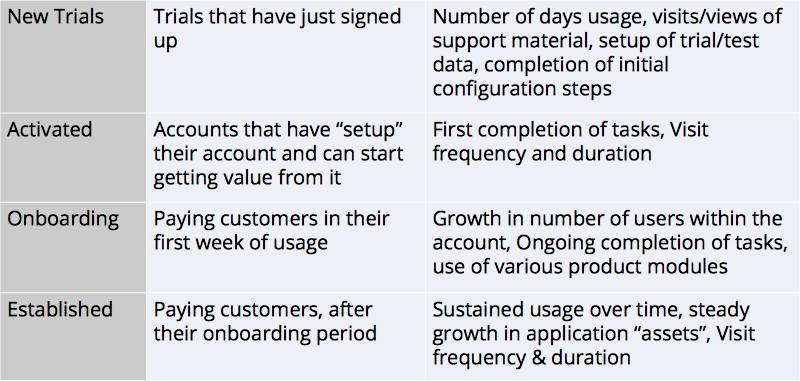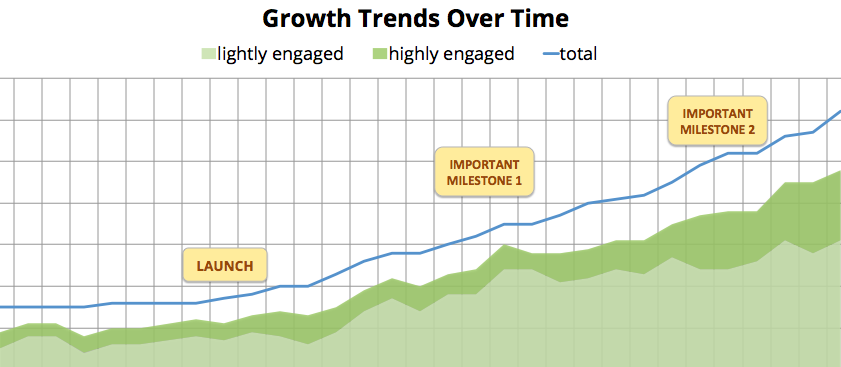Take a step back and you’ll realize user-engagement is the single most important metric in any SaaS business.
In a world where customer evaluate your offering at their own pace, and can cancel their subscription at any time, the best way to maximize your business potential is to make sure users are engaged and see value in your offering.
And the best way to ensure that is to create a metric which can be monitored for change and improvement on an on-going basis.
It has been somewhat surprising for us to see that most SaaS companies (and we’ve spoken to hundreds by now) are somewhat at a loss as to how to actually measure their user’s engagement with their offering and application. In fact, when pressed many admit that, important as it is to their business, they actually *don’t* measure user engagement. Simply because they could not figure out a systematic way to!
Since we’re here to help SaaS companies do better in this area, here’s our 3 step guide to getting started.
Step 1: Segment your users into lifecycle stages
The signals engagement for a trial user that has just signed up vs. an established customer is very different. Trying to come up with an engagement metric that applies throughout all lifecycles is practically impossible. Consider the following (in a fictitious SaaS application):
User1: Signed up last week, has logged in 5 times, created a project with some content and reviewed our knowledge-base 3 times
User2: Paying customer for a year. Last week logged in 5 times, created a project with some content and reviewed our knowledge-base 3 times
Clearly User1, as a new trial user, is exhibiting a good level of engagement, whereas the behavior of User2, a year into their subscription, is concerning at best.
We recommend you break down user lifecycle at least into the following stages. We also suggest some ideas of things you’d want to look at as you compute engagement at each stage

You’d want to apply a different engagement metric to users depending on where they are in the process.
Step 2: Create a scale
Engagement is not a binary metric. Users are not either engaged or unengaged, but rather fluctuate on a scale. We recommend creating the following buckets:

The time window to measure varies. we typically suggest 14 days – 30 days, depending on the application’s complexity.
For a top-line view, you eventually want to end up with a dashboard similar to that shown below.
The chart shows, number of total, highly engaged and lightly engaged users overtime. For convenience, we overlay important milestones (product releases, marketing campaigns, etc.) so we can see their affect on our users.
For example, we see a good pickup of total activated users after launch . Growth is mainly in lightly engaged users however.
Important milestone 1 made almost no impact (maybe it wasn’t that important after all? 🙂
Important milestone 2 on the other had, clearly increased the number of highly engaged users (we should do more of that)

Step 3: Constantly refine & improve
Your engagement metrics should not be static but evolve over time. You should constantly “test” them against users eventual decision to purchase or cancel their subscription. If they don’t provide a good enough prediction as to what a user is likely to do with their account, the metric and its underlying formula should be tweaked.
Specific Examples:
- “Highly Engaged” Trial users should convert at a very high conversion-rate to paying accounts
- “Gone” and “Fading” Paying users would tend to churn if left unchecked
Summary
Measuring engagement can be tricky, but is absolutely essential for success in a SaaS environment.
A corporate-wide engagement metric helps:
- The product-teams improve the product’s value to customers
- The sales team focus on trial accounts that matter most
- The customer-success team identify and proactively manage paying-customers
- And helps marketing teams bring more qualified, relevant leads
It should be part of every SaaS organization’s core-competency. Get it implemented in yours today!

Do you know how to measure your Customer Engagement?
Our SaaS Dashboard can easily do that for you!
Try it now

Lena Charles says:
Optimizing and measuring for the correct engagement metrics is very important for keeping and attaining users. If you want to know more about how to measure user engagement in your mobile app or how to make your app better based on the results, you should check out this blog pendo.io